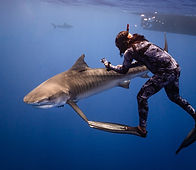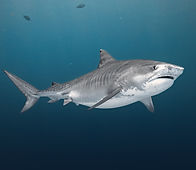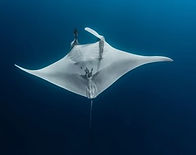
Ongoing research projects
Current shark research ongoing in Fuvahmulah

Tiger Shark Photo ID
The first research idea and official research project in Fuvahmulah. Ongoing since 2017. The Tiger Shark Photo ID project aims to identify individual tiger sharks in Fuvahmulah to enhance our understanding and monitoring of this important population. Our trained team of marine biologists uses the unique countershading delineation pattern of each shark to identify them during every shark dive. To date, we have successfully identified 267 individual sharks. This meticulous identification process allows us to track the movements, behaviors, and population dynamics of tiger sharks around Fuvahmulah, contributing valuable data for their conservation and management.

Environmental Influences on Tiger Shark Presence
The Environmental Influences on Tiger Shark Presence project investigates how various environmental variables affect the presence of tiger sharks in Fuvahmulah. The study focuses on lunar phases, wind speed and direction, wave height and direction, temperature, tides, and weather conditions. These variables are meticulously collected both in situ and through satellite data. Key findings from this research indicate that fewer tiger sharks are observed during rainy conditions and full moons, while higher surface temperatures correlate with an increase in tiger shark sightings. This project provides critical insights into how environmental factors influence tiger shark behavior and distribution, aiding in their conservation and management.

Thresher Shark Habitat Use and Behavior
The Thresher Shark Habitat Use and Behavior study aims to quantify the cleaning patterns of pelagic thresher sharks at the cleaning stations around Fuvahmulah. To achieve this, we deploy remote stereo cameras at these stations to collect comprehensive data on their habitat use and behavior. This innovative approach has gathered significant evidence of cleaning behavior in thresher sharks. These findings enhance our understanding of their ecological interactions and contribute to the broader efforts of conserving this endangered species by highlighting the importance of cleaning stations in their daily lives.

Tiger Shark Social Behavior
The Tiger Shark Social Behavior project aims to identify social preferences and hierarchies within the local tiger shark population in Fuvahmulah. We observe and record social interactions among tiger sharks, focusing on behaviors such as parallel swimming, stand back, and swim by. Through observations, we have identified clear patterns of social interactions and dominance behaviors among the sharks. These insights provide a deeper understanding of tiger shark social structures, contributing to our knowledge of their behavior and aiding in the development of effective conservation strategies.

Tiger Shark Pregnancies (Tiger Shark Momma project)
The Tiger Shark Pregnancies project aims to identify and monitor pregnancies in tiger sharks, tracking their movements to understand when they leave and return from birthing. We detect pregnancies by observing abdominal distensions and using an underwater ultrasound. During a two-week study, we scanned 35 sharks and identified 25 pregnancies. A key finding from this research is that Fuvahmulah serves as an important gestation area for pregnant tiger sharks. This information is crucial for understanding tiger shark reproductive health and developing conservation strategies to protect these vital habitats.

Anthropogenic Influence on Tiger Shark Numbers
The Anthropogenic Influence on Tiger Shark Numbers project investigates how human activities, specifically diving at a provisioning site, affect the presence of tiger sharks in Fuvahmulah. To assess this impact, we are collecting data on the number of tiger sharks spotted per dive, the amount of bait brought, the number of divers present, and the presence of dive vessels. Although the analysis is still ongoing and no findings have emerged yet, this study aims to provide valuable insights into how human interactions and provisioning activities influence tiger shark behavior and population dynamics. Understanding these impacts is essential for developing sustainable practices that minimize human disturbance while supporting shark conservation efforts.

Silvertip Behavior
The Silvertip Behavior study aims to investigate the interactions and behavior of silvertip sharks around tiger sharks at a tiger shark provisioning site in Fuvahmulah. We observe and record silvertip behavior in situ during dives, following a set of predefined behaviors to ensure consistency and accuracy. Our observations indicate that there are high seasons when silvertip sharks are more prevalent, and they exhibit significant avoidant behavior around tiger sharks. These findings enhance our understanding of the behavioral dynamics between silvertip and tiger sharks, providing insights that are crucial for managing shark populations and their interactions within shared habitats.

Titan Triggerfish Attacking Tiger Sharks
The Titan Triggerfish Attacking Tiger Sharks project investigates the interactions between titan triggerfish and tiger sharks at a provisioning site in Fuvahmulah. This study aims to understand the aggressive behaviors displayed by titan triggerfish towards tiger sharks during provisioning dives. By observing and documenting these interactions, we have noted instances of triggerfish attacking and harassing tiger sharks. These findings provide valuable insights into the interspecies dynamics within this ecosystem, highlighting the aggressive nature of titan triggerfish and its potential impact on tiger shark behavior and well-being. Understanding these interactions is crucial for managing the complex relationships between different marine species in shared habitats.

Ecological Assessment of Fuvahmulah
The Ecological Assessment of Fuvahmulah project aims to utilize Baited Remote Underwater Video systems (BRUVs) to monitor and track the relative abundance of shark species and overall biodiversity around Fuvahmulah. By deploying BRUVs, we aim to gather comprehensive data on the diversity and population dynamics of sharks in this region. Currently, the project is in its pilot phase as we await funding to fully implement our research plan. This assessment is crucial for understanding the ecological health of Fuvahmulah's marine environment and will provide valuable insights for conservation and management efforts once fully operational.

Oceanic Manta ID Project with Manta Trust
The Oceanic Manta ID project with Manta Trust aims to assist in logging sightings of Oceanic Mantas and capturing photographs of their unique underside patterns for identification. By collecting detailed images of these patterns, we can accurately identify individual mantas and track their sightings over time. This process allows us to help Manta Trust estimate the population size of Oceanic Mantas around Fuvahmulah and monitor the frequency of resightings. Through this collaboration, we contribute to a deeper understanding of manta ray populations, aiding in their conservation and providing crucial data for ongoing research efforts.

Whale Shark ID Project with Maldives Whale Shark Research Program
The Whale Shark ID Project with the Maldives Whale Shark Research Program (MWSRP) focuses on logging sightings of whale sharks and capturing photographs of their unique patterns for identification purposes. By taking detailed images of these patterns, we can accurately identify individual whale sharks and monitor their movements over time. This methodology allows us to estimate the population size of whale sharks around Fuvahmulah and track the frequency of resightings. Through this collaborative effort, we enhance our understanding of whale shark populations, supporting their conservation and providing essential data for MWSRP's ongoing research initiatives.

Tiger Shark Social Network Analysis
The primary aim of the tiger shark social network analysis is to characterize the social network dynamics and associations among tiger sharks in Fuvahmulah while investigating the influence of residency patterns, site fidelity, and reproductive characteristics on their social organization.

Tiger Shark Healing abilities
This project investigates the remarkable healing capabilities of tiger sharks in Fuvahmulah, using long-term photo ID data to track wound recovery over time. By documenting injury progression and regeneration, we aim to better understand shark resilience and the implications for their survival in high-risk environments.

Tiger shark Fidelity to Fuvahmulah
The primary aim of the tiger shark social network analysis is to characterize the social network dynamics and associations among tiger sharks in Fuvahmulah while investigating the influence of residency patterns, site fidelity, and reproductive characteristics on their social organization.

Our diverse array of projects at Fuvahmulah showcases our commitment to advancing shark conservation and marine research in Fuvhamulah. From the detailed identification and monitoring of tiger sharks through our Photo ID project to uncovering the subtle influences of environmental variables on their presence, our work is at the forefront of marine science. We delve into the intricate social behaviors of tiger sharks, track their pregnancies with innovative ultrasound techniques, and explore the complex interactions between species, such as silvertip sharks and titan triggerfish. Our pioneering efforts extend to quantifying the cleaning patterns of thresher sharks and utilizing state-of-the-art BRUVs to assess the ecological richness of Fuvahmulah. Each of these projects underscores the critical importance of preserving shark habitats. Join us on this exciting journey as we unravel the mysteries of the deep and drive impactful conservation efforts for the future of our oceans!

